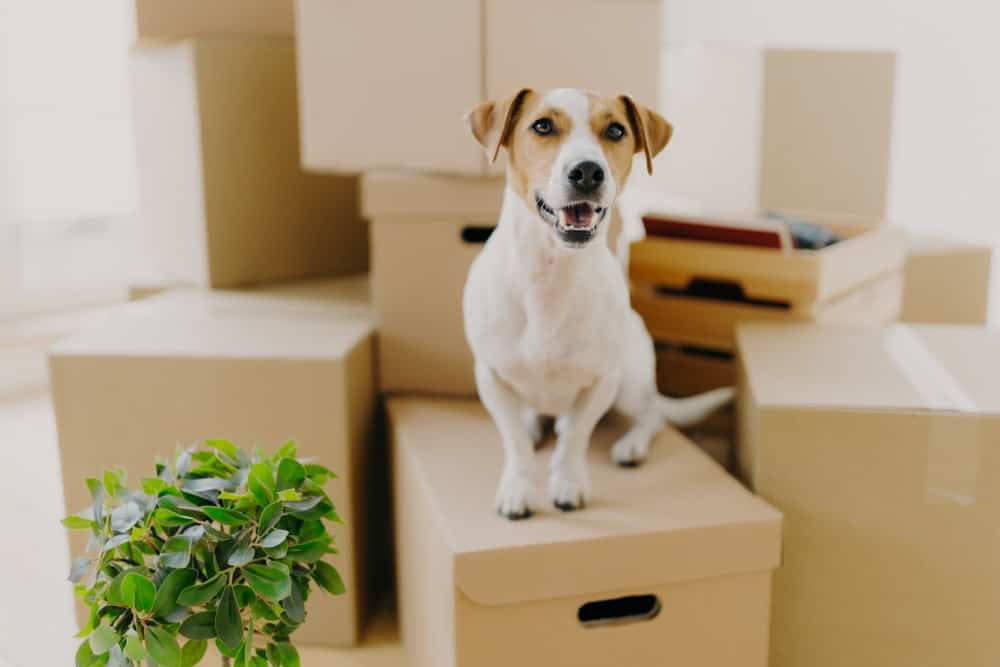“This post contains affiliate links, and I will be compensated if you make a purchase after clicking on my links.”
You may see it as an adventure, but moving to a new home can be an intimidating process, especially for your pet. It can make them uncomfortable and lead to a lot of “unspoken questions” oozing out of those puppy eyes.
While you can’t eliminate the stress and discomfort that a move can have on your pet, there are plenty of ways to ameliorate the trauma of relocating to a new home.

Don’t Rush the Process
For starters, whenever possible, don’t rush the moving process. This is true for all moves, but when you’re also looking for a pet-friendly space, in particular, waiting until the last minute can lead to settling for a place that you wouldn’t necessarily have chosen if you had more time. In addition, you can end up forced to accept higher rent or a bigger mortgage.
Instead, start your search with plenty of time to spare. This is typically at least eight weeks before your lease is up when renting and a minimum of four months if you’re looking to buy a house.
Lay the Groundwork and Tend to the Logistics
As the big moving day approaches, it’s a good idea to lay some groundwork with your pet. Brush up on their training and don’t forget to incorporate any new rules they may need to know for their new home. Most importantly, remember to spend plenty of one-on-one time with your dog. You can also set up empty boxes in your old space early on in the process to help them slowly acclimate to the moving environment.
Along with prepping your pup emotionally, it’s a good idea to tend to some of the pet-centered logistics involved with a move. Update your new address on their tags, sort out if you can keep your current vet or if you need to find a new one, and make sure you understand your pet insurance policy before you start the transition to a new home.
Choose a Housing Option That Fits Your Pup
When it comes to the new home itself, there are many different kinds of housing options to choose from. However, it’s important to pick a location that will easily accommodate your pet.
For instance, a single-family home is typically the best option for a dog, although some apartments allow animals as well. You can also look for alternative rent options such as renting someone’s spare room or an in-law apartment. On sites like Craigslist, private listings of this kind are often more open to having pets.
Learn Your New Environment First
When it comes to setting up your new house or apartment, it’s important to visit the space without your pet first. Once there, look at the home inside and out using three different perspectives:
- Your pup: Consider what your pup will need. Where will they sleep? Do they have space to roam around during the day? Are there any nearby parks or local walking options?
- Yourself: What will you need to do in order to care for your pup in this environment? Will you need to bend over backward to keep your dog from barking? Will you need to drive a half-hour to reach an area that’s okay to walk in?
- Your landlord: If you’re renting, will your landlord look kindly on the fact that you have a pet, or will it create tension? How would you want a pet to live and behave in the space if you were the landlord?
Considering these three perspectives can help to pave the way for a smooth transition for both you and your dog.
Take the Time to Transition
When it comes time to move, carefully choose when and how to start acclimating your dog to their new home. Here are a few things to consider:
- Looking for ways to scent your new abode with familiar smells.
- Doing any renovations that may stir up dust, mold, or even asbestos before your dog is on the premises.
- Planning the safest way to move your pup to your new home, whether it’s by airplane, in the back seat of your car, or simply by walking.
- Deciding if you’ll need medication if your canine isn’t accustomed to traveling.
If you plan your dog’s transition carefully, you can make them the focal point throughout the journey to their new home. This can help them stay calm and collected as they transition to an entirely new, initially uncomfortable new home.
Finding a Home for Your Pup and Yourself
Finding a home that suits both your pup and yourself can be tricky. However, if you take the proper amount of time to choose your new home, lay the groundwork, and make a safe transition plan, you can successfully move to a new home without stressing out your best friend.
Once the move is complete, focus on your pup as much as you can and strive to be as consistent as possible. If you can do this, the entire event will have minimal impact on your dog’s health and emotions, freeing them to embrace the adventure right alongside you.
Jori Hamilton is a writer from the pacific northwest. You can follow her on twitter @Jori Hamilton and see more of her work at writerjorihamilton.contently.com.
























Thanks for this article. Very soon we will shift to our new home with our pet. Your advice give solution to us. Thanks.
[…] also pet-safe, easy to clean, and stain and odor resistant. It’s also a good idea to allow your pet to visit the new house a time or two before you actually move in for good. Have a favorite toy, a comfy bed, and a food and water bowl […]